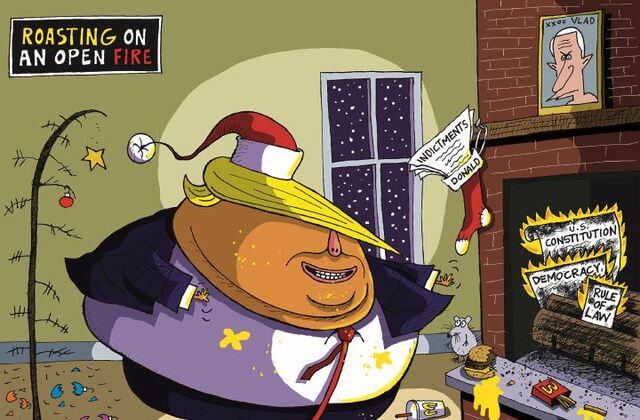[ad_1]
CONCORD, N.H. (AP) — Rudolph the red-nosed reindeer may have had millions of carrots for himself on Christmas Eve, but what about the rest of the year?
Finding food in the cold, barren landscape is challenging, but researchers at Dartmouth College in New Hampshire and the University of St. Andrews in Scotland report that deer’s eyes have evolved to help them easily spot their favorite food.
This is further proof that reindeer are famous for pulling Santa’s sleigh, says Nathaniel Dominy, a Dartmouth anthropology professor and co-author of a recent study published in the journal Eye-Perception. Separates.
“They’ve been somewhat obscure and unheard of in the history of visual neuroscience, but they’re having their moment because they have a really fascinating visual system,” he said in an interview.
Scientists have known for years that the mirror-like tissue in deer eyes changes color from green to gold in the summer bright blue in winter, a process that is believed to increase the low light of the polar winter. But they weren’t sure what to make of another curious fact: unlike other mammals, deer can see light in the ultraviolet spectrum.
political cartoon

“Most animals that are active during daylight want to avoid UV light. UV light is harmful, Dominy said. “Snow reflects UV light, which is a problem, which is why humans get snow blindness.”
Some scientists believe that reindeer vision evolved to protect the animals from predators, allowing them to see white wolves in snowy landscapes, for example. The new study points to another possibility: food.
Reindeer depend largely on light-colored reindeer moss, which is not actually moss but a type of lichen that grows in crunchy, carpet-like patches in northern latitudes.
The researchers traveled to the Cairngorms mountains in the Scottish Highlands, which host more than 1,500 species of lichen as well as Britain’s only reindeer herd. They found that reindeer moss absorbs UV light, meaning that the white lichen that humans have trouble seeing against the snow appears as dark spots to animals.
“If you’re a buck, you can see it and you have an advantage because then you’re not moving around the landscape. You can walk in a straight line and get to that food, and in the process you save energy,” Dominy said. “These animals are desperate for food, and if they can find enough lichen, they will benefit.”
Juan José Negro is a specialist in evolutionary ecology and conservation biology at the Spanish Council for Scientific Research. While his focus is primarily on birds of prey, he found the new reindeer research interesting.
“I love everything to do with colors and vision,” he said. “Every time I read other people’s works, something happens that sparks new ideas. …and in the case of reindeer, it’s inspiring me to pay more attention to this part of the spectrum.
While he didn’t see any immediate biomedical benefits in the research, this kind of work is useful in furthering the understanding of how animals deal with difficult environments, he said.
Dominy reiterated the same point, but said it also had humanitarian implications. A lot of medicinal research has been done on lichens because they have antioxidant properties. He said that exposing reindeer eyes to UV light suggests that some mechanism may be in place to protect them from damage.
“Deer eyes are full of ascorbic acid or vitamin C and vitamin C is great for repairing damaged cells,” he said.
With that in mind, Dominy is updating the advice he offered after writing a 2015 paper that explained why a reindeer’s red nose would be ideal for guiding Santa’s sleigh.
At that time, he advised children to give up Rudolph cookies and other high-calorie foods so that he could replenish body heat through his nose. Now, he says, focus on her eyes and save the milk and cookies for Santa.
“The best thing to do to protect their eye health would be to give them something rich in vitamin C,” he said. “Orange juice, carrots, these would be perfect treats for the reindeer on Christmas Eve.”
Copyright 2023 The associated Press, All rights reserved. This material may not be published, broadcast, rewritten, or redistributed.
[ad_2]
Source link
